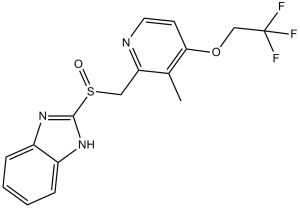This product is for research use only, not for human use. We do not sell to patients.

| Size | Price | Stock |
|---|---|---|
| 1g | $250 | Check With Us |
| 5g | $700 | Check With Us |
| 10g | $1050 | Check With Us |
Cat #: V1638 CAS #: 138530-94-6 Purity ≥ 98%
Description: Dexlansoprazole (formerly known as T168390; TAK390; Kapidex; Dexilant, R-Lansoprazole and TAK-390MR), the dextrorotatory or R-enantiomer of lansoprazole, is a proton pump inhibitor (PPI) formulated to have dual delayed-release properties by employing a novel release formulation that prolongs its absorption.
Publications Citing InvivoChem Products
Product Promise

- Physicochemical and Storage Information
- Protocol
- Related Biological Data
- Stock Solution Preparation
- Quality Control Documentation
| Molecular Weight (MW) | 369.36 |
|---|---|
| Molecular Formula | C16H14F3N3O2S |
| CAS No. | 138530-94-6 |
| Storage | -20℃ for 3 years in powder formr |
| -80℃ for 2 years in solvent | |
| Solubility In Vitro | DMSO: 74 mg/mL (200.3 mM)r |
| Water:<1 mg/mLr | |
| Ethanol: 74 mg/mL (200.3 mM) | |
| Synonyms | T-168390; TAK-390MR; TAK-390; T168390; TAK390; T 168390; TAK 390; Dexlansoprazole; Dexilant; Kapidex; TAK 390MR; TAK390MR |
| Protocol | In Vitro | The plasma concentrations of (R)-lansoprazole are remarkably higher in all three CYP2C19 genotype groups than those of the corresponding (S)-enantiomer. The AUC0-∞ Cmax and elimination half-life of (R)-lansoprazole are significantly greater and longer, respectively, than those of the (S)-enantiomer for all three genotype groups |
|---|
| Solvent volume to be added | Mass (the weight of a compound) | |||
|---|---|---|---|---|
| Mother liquor concentration | 1mg | 5mg | 10mg | 20mg |
| 1mM | 2.7074 mL | 13.5369 mL | 27.0739 mL | 54.1477 mL |
| 5mM | 0.5415 mL | 2.7074 mL | 5.4148 mL | 10.8295 mL |
| 10mM | 0.2707 mL | 1.3537 mL | 2.7074 mL | 5.4148 mL |
| 20mM | 0.1354 mL | 0.6768 mL | 1.3537 mL | 2.7074 mL |
This equation is commonly abbreviated as: C1 V1 = C2 V2
- (1) Please be sure that the solution is clear before the addition of next solvent. Dissolution methods like vortex, ultrasound or warming and heat may be used to aid dissolving.
- (2) Be sure to add the solvent(s) in order.




































